Maxus e Deliver 3 electric van review (2024)
Quirky pure electric van with excellent driving range accuracy
PROS
- Reliable and accurate driving range
- Speedy performance
- Good payload for its size
- Low running costs
- Optimised construction
CONS
- Rivals offer bigger batteries
- Rivals offer greater load capability
- Not particularly well equipped
- Not particularly well priced
- Cramped interior full of quirks
Summary
The Maxus eDeliver 3 conforms to some of the conventions for an electric van - it has all the usual space for passengers and cargo - but is one of the quirkier vans on sale in the UK.
It is powered by a battery and electric motor combo, but this is nothing too out of the ordinary at the moment, but is otherwise very different to many of the seemingly identical vans in a similar size bracket.
First things first, if the Maxus brand isn’t familiar to you, this is the new name for what used to be LDV in the UK; LDV having been acquired by Chinese automotive giant SAIC in 2010, which began using the Maxus name almost immediately but only finalised the change globally in 2020.
What is the Maxus eDeliver 3?
The Maxus eDeliver 3 is an electric van. And we mean only an electric van – there is no diesel, petrol or even plug-in hybrid version of this model. It was always designed to be electric, too, so is built using lightweight materials including aluminium and composites to compensate for the heft of the batteries. This is all beneficial when it comes to driving range, performance and payload.
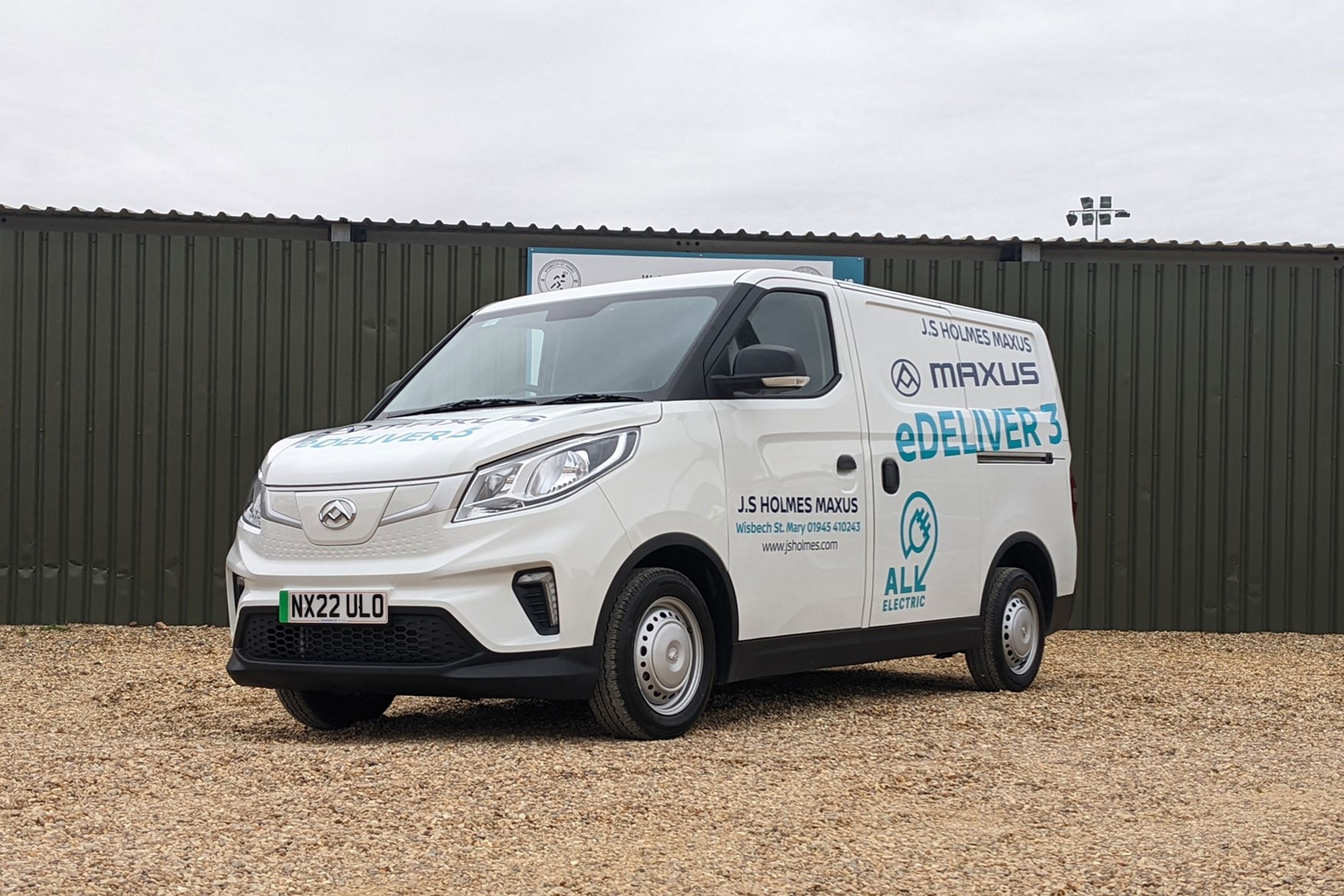
However, the curiosities start with its unusual size. The eDeliver 3 sits right on the border between typical small vans and medium vans, with a load space that’s slightly bigger than the former but more compact than what’s typical for the latter – although this is partly because only the short-wheelbase L1 panel van model is sold in the UK at the moment.
A long-wheelbase chassis cab is also available for use in bespoke conversions, but the long-wheelbase L2 panel van offered elsewhere in the world is presently not an option on these shores.
What’s the driving range of the Maxus eDeliver 3?
The Maxus eDeliver 3 originally came with a choice of two battery sizes, 35kWh and 50.23kWh, both using the same type of 'tenary lithium polymer' technology that's also used by Tesla. However, the latter is the only one that is listed on the price list at the time of writing.
On paper, according to official WLTP results, this gives the eDeliver 3 a 'combined' driving range per charge of 99 miles or 151 miles, respectively. This increases to 141 miles or 213 miles in exclusively urban driving, where the stop and start of traffic helps keep the batteries topped up.
The best-performing rival electric vans – the Citroen e-Dispatch, Peugeot e-Expert, Toyota Proace Electric and Vauxhall Vivaro-e, which are all fundamentally the same vehicle – claim up to 205 miles per charge in regular driving, thanks to a larger 75kWh battery pack option. But we’ve found this claim to be a little disappointing in reality.
With its bespoke electric vehicle design, the eDeliver 3’s kerbweight is well over 400kg less than those Stellantis-built competitors. A huge amount that makes a huge difference to the efficiency of the drive system.
So although it may not ultimately go as far, in our testing the Maxus has shown exceptionally accurate range prediction that is unfazed by motorway speeds or fast driving on B-roads, while every other electric van we’ve driven significantly has been.
This is a strong reason to consider this electric van very seriously.
How practical is the Maxus eDeliver 3?
As long as you don’t need more than 4.8 cubic metres of load space and can cope with the complexities of running an electric van, then it does a perfectly reasonable job.
What complexities? As with all electric vans, the eDeliver 3 takes much longer to recharge than an equivalent diesel does to refuel, so it makes most sense when daily use is within its specified driving range and it’s then recharged overnight, or between shifts. Plugging in throughout the day unlikely to be practical for most owners or operators.
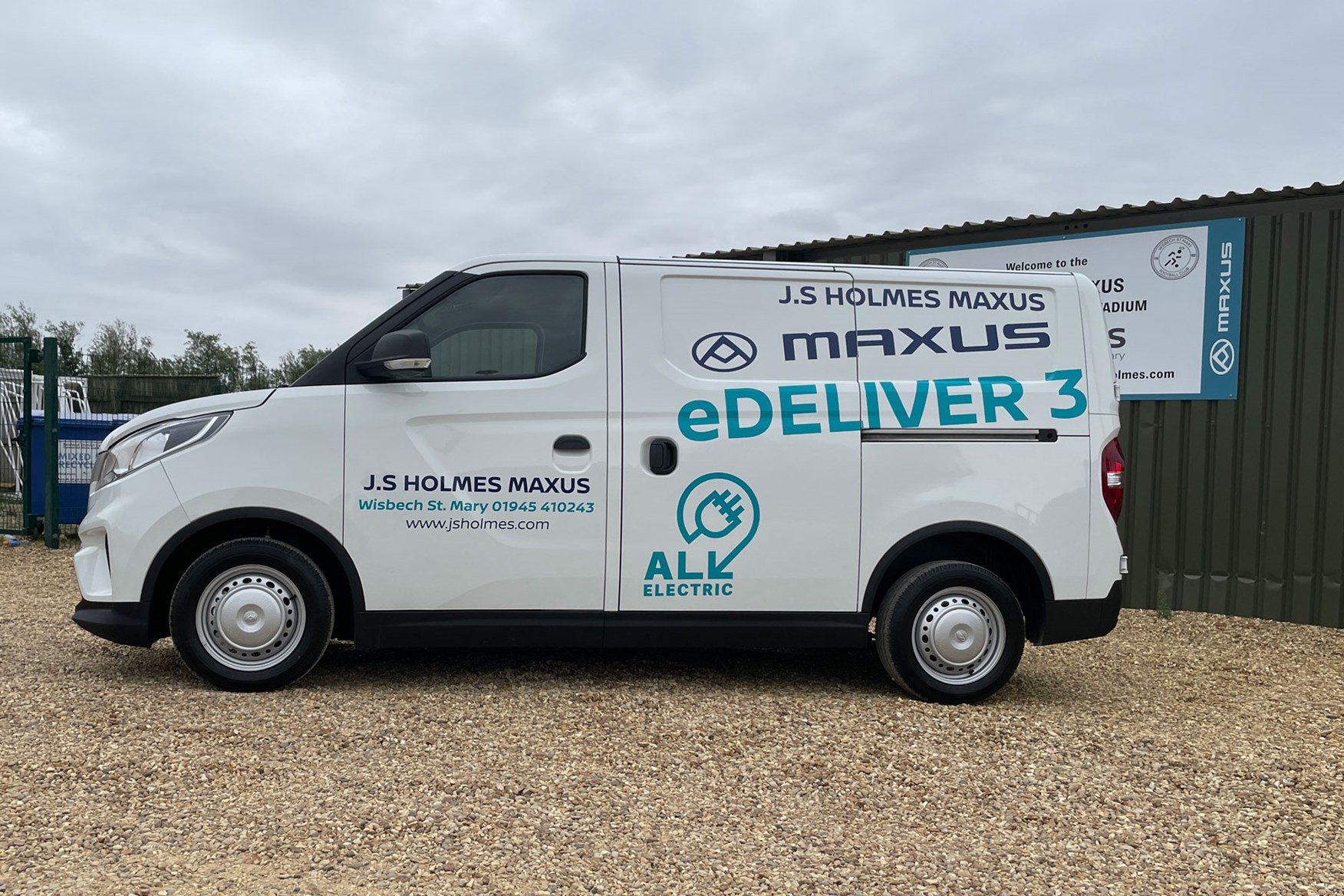
The eDeliver 3 is also only a two-seater (there’s no passenger bench option), and the cab may feel a little too constricting for taller drivers. The ventilation system and infotainment aren’t quite as we’ve come to expect from mainstream models, either. More on all this in the Interior section of this review.
For info on the load space, payload and towing capacity, see our Maxus eDeliver 3 dimensions page.
How long does the Maxus eDeliver 3 take to charge?
Using a DC rapid charger of the type found on the public charging network, an 85% charge takes 45 minutes for either battery pack size.
Using the type of AC charging found in domestic or workplace wallbox chargers, you’ll need six hours for the smaller battery and eight hours for the larger battery – though that is to 100%.
What are the eDeliver 3’s rivals?
The main challenge comes from the Stellantis vans: the Citroen e-Dispatch, Fiat E-Scudo, Peugeot e-Expert and Vauxhall Vivaro-e, which come in a range of trim levels and a choice of body sizes; the Toyota Proace Electric is also built by Stellantis for Toyota, using the same technology, but only comes in a single variant.
Toyota compensates for this with a 10-year warranty offering (the others have three years of cover).
The Mercedes-Benz eVito is also a medium-sized electric van, and has been boosted by an improved battery that gives it a much more competitive range and charging time. The Ford Transit Custom Plug-in Hybrid and LEVC VN5 offer electric capability backed up by petrol engines for long-distance use.
Given the eDeliver 3’s size, you might also consider a small electric van as an alternative. The best of these are also made by Stellantis at present: the Citroen e-Berlingo, Peugeot e-Partner, Toyota Proace City Electric, Vauxhall Combo-e and the forthcoming Fiat E-Doblo. Again, the Toyota benefits from a 10-year warranty option.
>> The best electric vans you can buy now
>> New electric vans coming soon
Verdict: is the Maxus eDeliver 3 any good?
This review goes into much greater detail about what the Maxus eDeliver 3 is like. But in short, with an accurate range prediction that matches closely to the official figures, it provides a very convincing example of the advantages of electric drive systems. The eDeliver 3 is easy to drive, has good performance and should prove very cheap to run.
However, the pricing puts it in direct competition with some outstanding mainstream electric vans, which offer more load space, higher payloads and fewer quirks. So while the eDeliver 3 is likeable, it’s tough to recommend it in comparison with a van such as the Toyota Proace Electric.
Skip to our full verdict on...
- Accurate driving range, even at motorway speeds
- Plenty of performance while also being efficient
- Easy to drive, comfortable enough, very light steering
The Maxus eDeliver 3 starts with a conventional twist of a conventional key. You have to wait a beat for a green light to come on in the instrument cluster before selecting drive or reverse using the selector dial on the centre console, or it won’t engage. The other oddity of this selector dial is the lack of park - you put it into neutral when you want to stop.
Similarly, a couple of times we caught it out by pressing the accelerator too soon when switching between forwards and backwards, which stops anything happening. This is easily fixed by turning the dial back to neutral and trying again. While this might be momentarily confusing, it’s probably a sensible safety feature.
Like most electric vans, there’s no conventional gearbox, just a single-speed transmission. This makes for smooth and – if required – rapid acceleration. The eDeliver 3 is not stupidly fast, but this is by no means a slow van, with plenty of punch should you need to quickly increase speed, for overtaking or even avoiding a hazard.
How fast is the Maxus eDeliver 3?
The eDeliver 3 comes with a 90kW electric motor that gives the equivalent of 122hp combined with 255Nm of torque, which the motor provides as soon as it starts spinning – the reason electric vans feel very lively at low speeds and accelerating from a standstill.
The eDeliver 3 keeps that sensation of performance at much higher speeds as well. So although the official 0-62mph is a relatively stately 11 seconds, in most situations it seems much nippier than that suggests.
Top speed is 75mph, which it has no trouble reaching and sustaining.
What’s the real-world driving range like?
This is the most impressive aspect of this van – we expect electric vehicles to be smooth and effortless to drive, so that part of the driving experience isn’t surprising.
But we have also found that most electric vans start losing driving range more quickly at higher speeds. To give a crude example, a van which says it will do 60 miles around town might only do 45 miles on the motorway, and often you find the range indicator starts plummeting as you go faster.
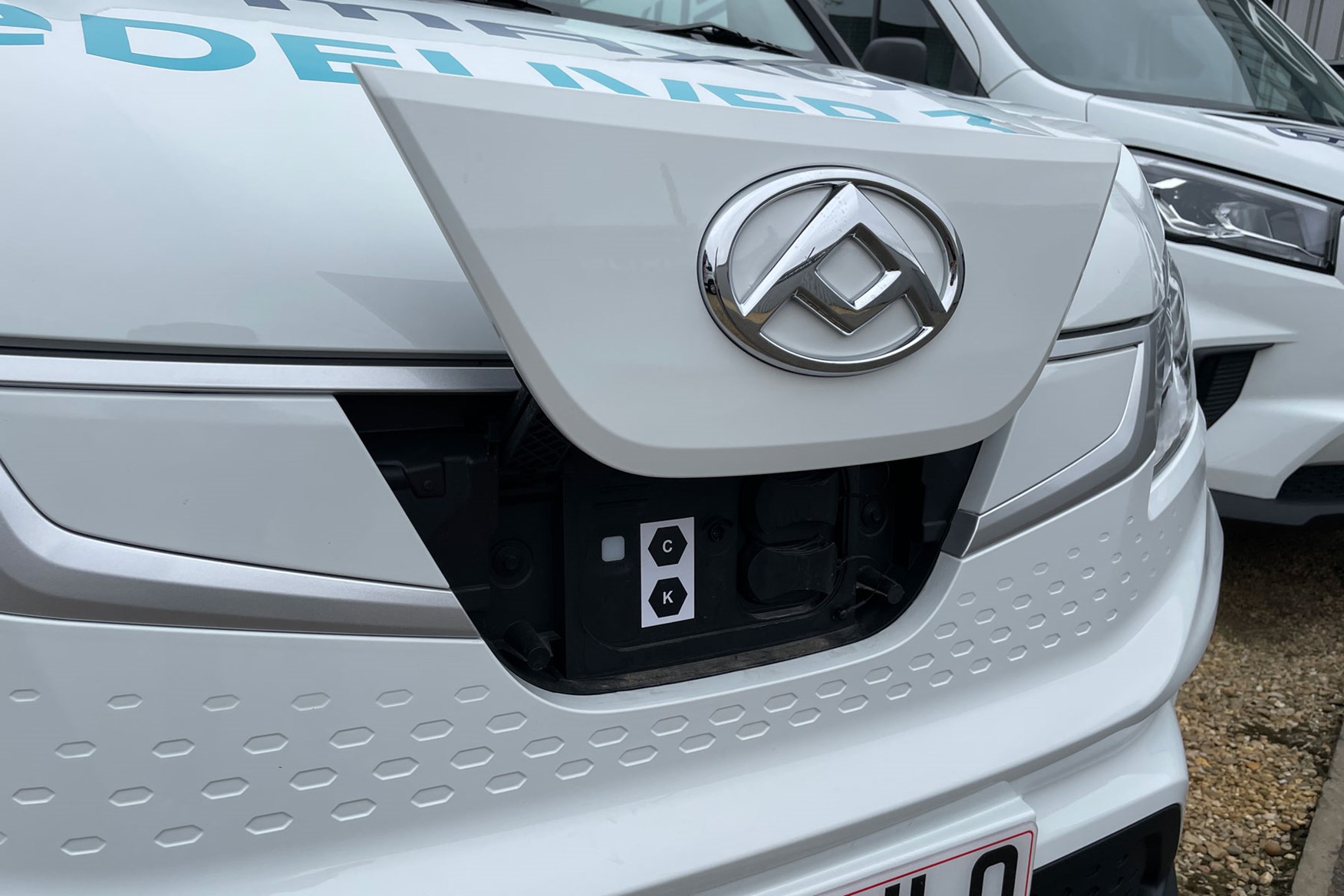
In the eDeliver 3, this doesn’t seem to happen. With the cruise control set we drove at the speed limit on motorways and dual carriageways – usually the toughest challenge for any electric van – and the range indicator continued to fall in line with the miles we were covering. In fact, we covered more miles than it initially suggested should be possible. A second drive, where we were deliberately punishing on to test the battery and range as much as possible and it retained its accuracy.
Partly this will be down to sensible calibration of the range indicator. But the eDeliver 3’s comparatively lightweight construction and the engineering of its electric drivetrain must also make a difference here.
The stop-start nature of town driving and even fast B-road driving – which both increase the recuperation of energy back into the batteries thanks to more frequent instances when the van is slowing down – saw the e Deliver perform still more efficiently for us.
Exactly what kind of range you’ll get out of the van will depend on your driving style (aggressive driving is always bad for efficiency) and how much payload you are carrying (heavier vans are also always less efficient). One caveat here is that we have yet to be able to test the eDeliver 3 with a payload on board, although we did drive with two adults in the cabin.
On what we have seen so far, though, we’re confident this electric van will go at least as far as it says it will on the dashboard.
Are there different driving modes?
As well as the standard driving more there is also an Eco setting. This restricts the top speed to 58mph to reduce electricity consumption, and is worth about five extra miles of driving range if you casually switch it on – probably more if you use it routinely.
Turning off the air-conditioning, on the other hand, instantly gives you an extra 10 miles of range.
The eDeliver 3 has three Regeneration modes, too, activated by the Reg switch beside the steering wheel. These control the degree to which the motor actively slows the van when you release the accelerator – the more the motor slows the van, the more energy it recuperates into the battery pack and the further you’ll go per charge.
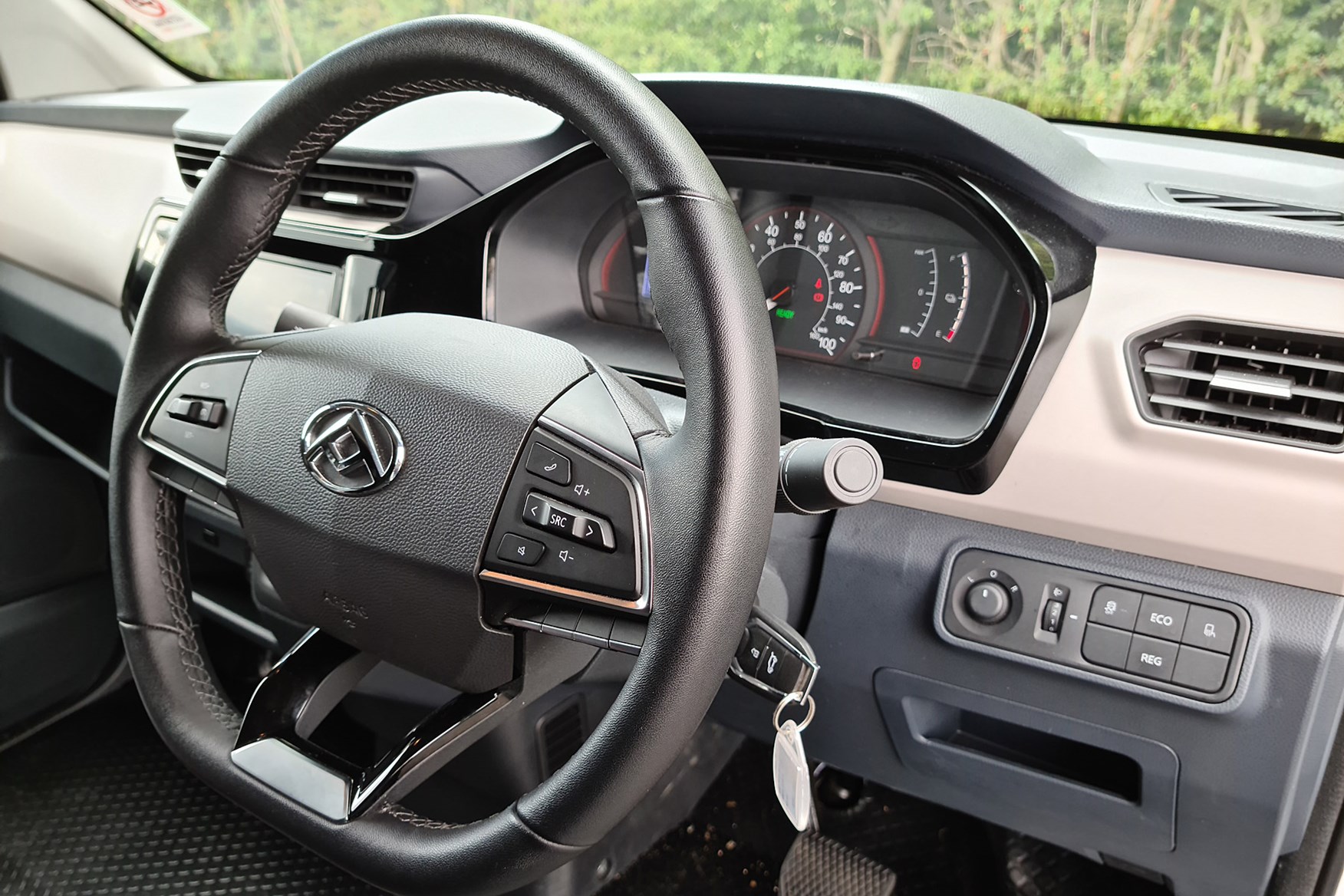
On the maximum setting, this gives you a fair degree of ‘one pedal’ driving, meaning that when you release the accelerator the van slows as if you were using the regular brakes.
This won’t bring you to a complete standstill in the eDeliver 3, but it’s enough of an effect that you can go several miles at a time without pressing the brake pedal, saving wear and tear on the brakes themselves and sending lots of energy back into the batteries.
Does the eDeliver 3 handle well?
The Maxus handles easily as well as it needs to. The electrically assisted power steering is light, so there’s not much feedback, but there’s quite a bit of body roll in the corners and the van communicates quite early on that it is likely to understeer (keep going straight) if you carry too much speed into a tight bend.
That’s nothing to be alarmed about, just a clear indicator that you are driving a commercial vehicle and not a sports car. It goes where you point it with no trouble at all, even if you drive it relatively quickly.
One challenge is the suspension, which, with no weight in the back, is firm and results in a bouncy and sometimes even crashy ride. The comparatively small wheels won't help on this front either.
With a payload rating of up to 900kg, firm rear suspension is to be expected to a degree, but it was noticeably worse than the larger eDeliver 9 and smaller similarly sized rivals.
- Slightly cheap feeling inside with hard surfaces
- Limited space for taller drivers, no covered storage
- Poor infotainment and unusual air-conditioning system
Fundamentally, the e Deliver 3’s interior is absolutely fine. But this is an area where some of the van’s quirks come back into play.
On first opening the door you’ll be greeted by the waft of a rubbery smell from the easy-clean floor surfacing. It’s not overwhelming but it is noticeable, in a way that you probably wouldn’t comment on the interior smell of a mainstream rival.
Is the e Deliver 3 comfortable?
The two seats seem fine in terms of comfort and durability – only time will tell with these – but the driver’s seat does not go back very far, and taller drivers are going to feel cramped. Even at 5’11”, this writer had the driver’s seat right up against the bulkhead.
What’s more, the seat rubbing against the bulkhead creates a creaking noise that’s at odds with the calm quiet of the electric drivetrain. This is likely to prove very annoying for some people.
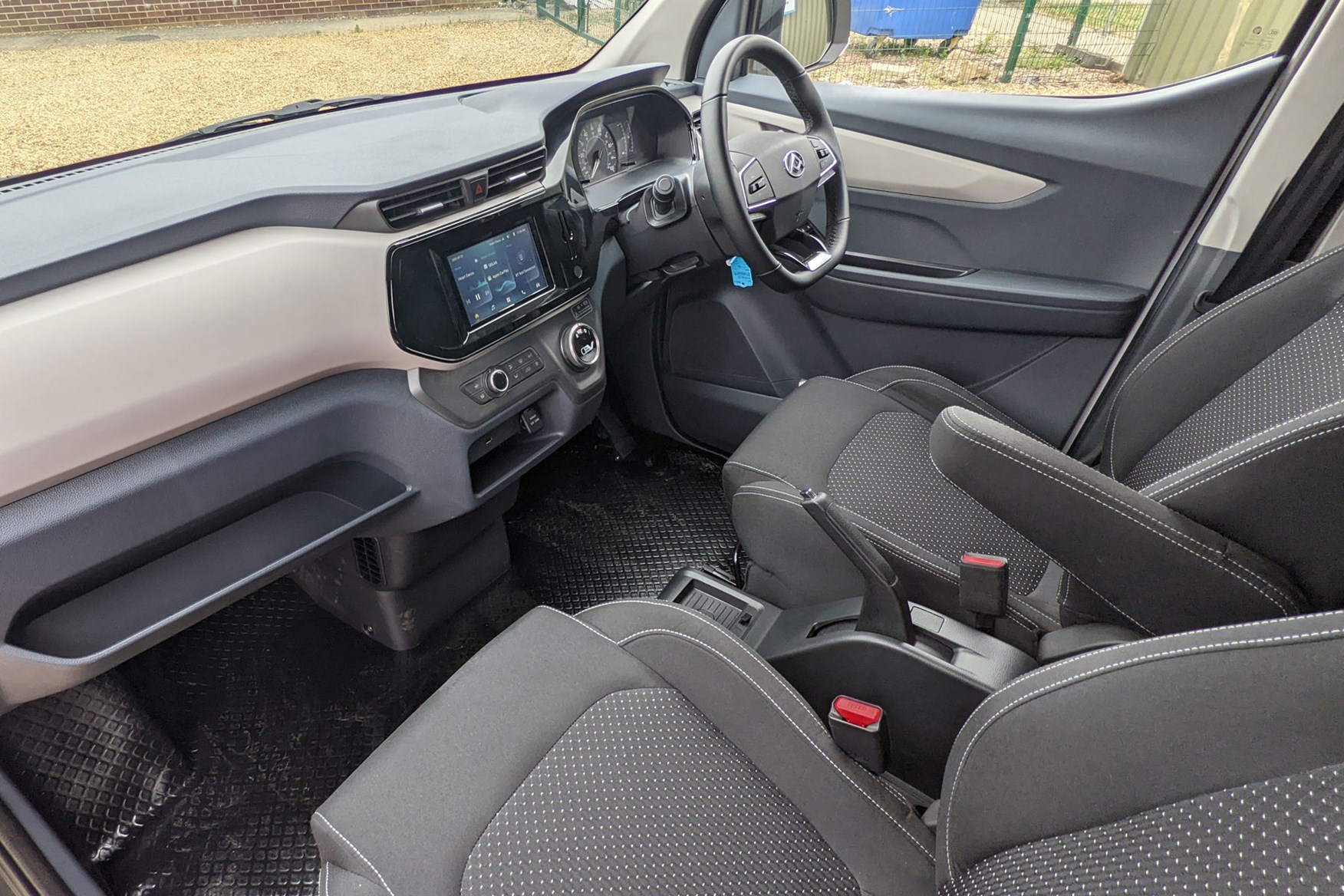
More of a bother to us was the hard plastic on the interior door handle, as this is uncomfortable to rest your elbow on. The material quality is generally a touch lower than you might hope, but it all seems to have been put together well enough. Take a little care with the flooring - it is a little slippery and particularly if you don't have much grip on your footwear. There are a few protruding screws coming out from the bulkhead, but they are in places where it is unlikely that you'll catch anything on them.
Small side windows may give some occupants a sense of claustrophobia, but forward visibility is fine.
What’s storage like in the cab?
While there are several places to stuff things about the cab, including reasonably large door pockets, none of these are covered and there’s no glovebox – just a slot on the dashboard instead.
The only cup holders are on the floor between the seats.
How modern is it inside?
The steering wheel is a modern, shaped affair with a stitched leather rim and buttons for the cruise control and the infotainment system; these feel a bit cheap but work as they should.
We did notice that the digital display for the set cruise control speed doesn’t match up with the analogue speedometer (the latter reads a few mph higher), but otherwise had no trouble using this.
The instrument cluster is dominated by that speedo, which is large and centrally positioned. On the right side you’ll find the ‘dials’ for the battery level and instant power consumption – but levels on these are represented by a series of lights rather than a moving needle. Simply enough to understand.
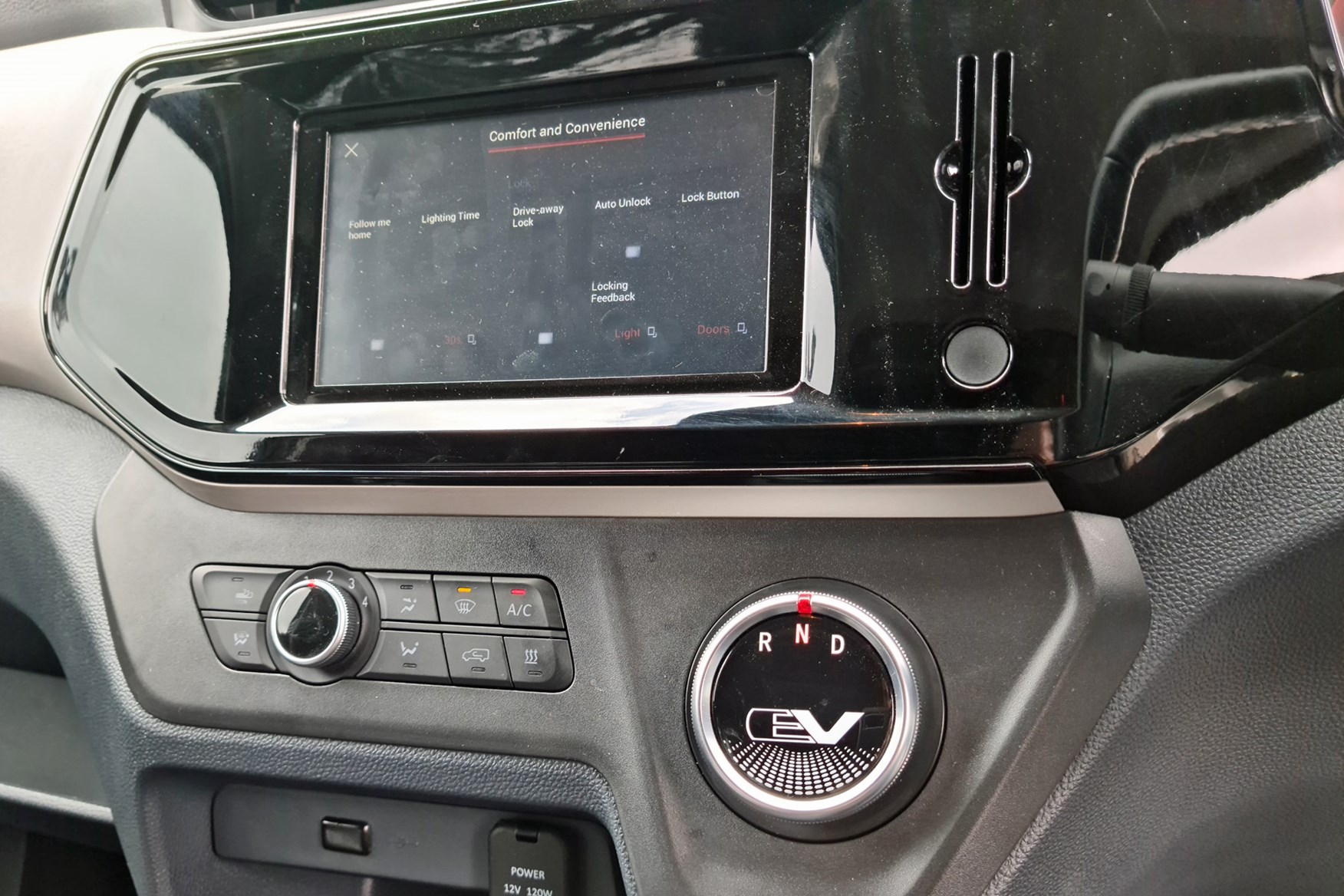
On the left side is a digital display, which allows you to cycle through various information screens, including the all-important remaining driving range and trip computer. This also shows cheerful advice messages.
This display is controlled by an old-fashioned trip stalk that spears out of the instrument cluster, rather than by a button on the steering wheel, making it less easy to use on the move than it could be.
So where does it start to go wrong?
The touchscreen infotainment system in the centre of the dashboard is easy enough to navigate and doesn’t feel too laggy. It does have Apple Carplay and Android Auto but, oddly, no DAB radio. There are two USB slots, so both driver and passenger can charge their phone, but only one connects to the screen.
Things get really weird with the ventilation controls for the air-conditioning system. They look ordinary enough, until you realise there’s no way of adjusting the temperature…
Instead, Maxus gives you a choice of warm or cool, with a ‘comfort’ button labelled Econ that adjusts the intensity of each. On a hot day we found the cool setting perfectly pleasant, but if you’re used to setting the temperature ‘just right’, you may have to do a bit of mental reshuffling to get your head around this approach.
There is also a fair degree of noise in the eDeliver 3, both while you're stationary and while you are on the move. This starts before you even set off - unlocking the van produces a sharp and loud blip of the horn, which is unlike any other vehicle we've come across of late. It could easily make you unpopular in a quite neighbourhood when you are on the early shift.
The noises continue when you are on the move, too, with a few more whirrs and hums at lower speeds than most electric vehicles produce in the cabin these days and a very loud beep from the reversing camera. There isn't much in the way of sound deadening either, so you get loads of wind noise and you'll hear every stone that pings up into the wheel arches.
- Cheap to run, competitively priced
- Not a huge amount of standard kit, few options
- Five-year warranty
Like all electric vans, the eDeliver 3 might look a little expensive on paper, but the promise of reduced running costs thanks to the lower cost-per-mile of electricity compared with diesel goes a long way towards compensating for that.
So too do the current electric van tax rates, which are reduced to £0 for both road tax and benefit-in-kind company van tax. There’s no fuel benefit charge on electricity either.
>> The Parkers guide to van tax
How much does the Maxus eDeliver 3 cost?
At the time of writing in early 2024, prices for the Maxus eDeliver 3 electric van start at £34,000 with the larger 52.23kWh battery pack. The 35kWh battery version isn't currently listed on the price list, but was £3,000 cheaper when it was last on there.
That’s excluding VAT and before the reduction available from the UK government Plug-in Van Grant, which will save you a substantial chunk of money.
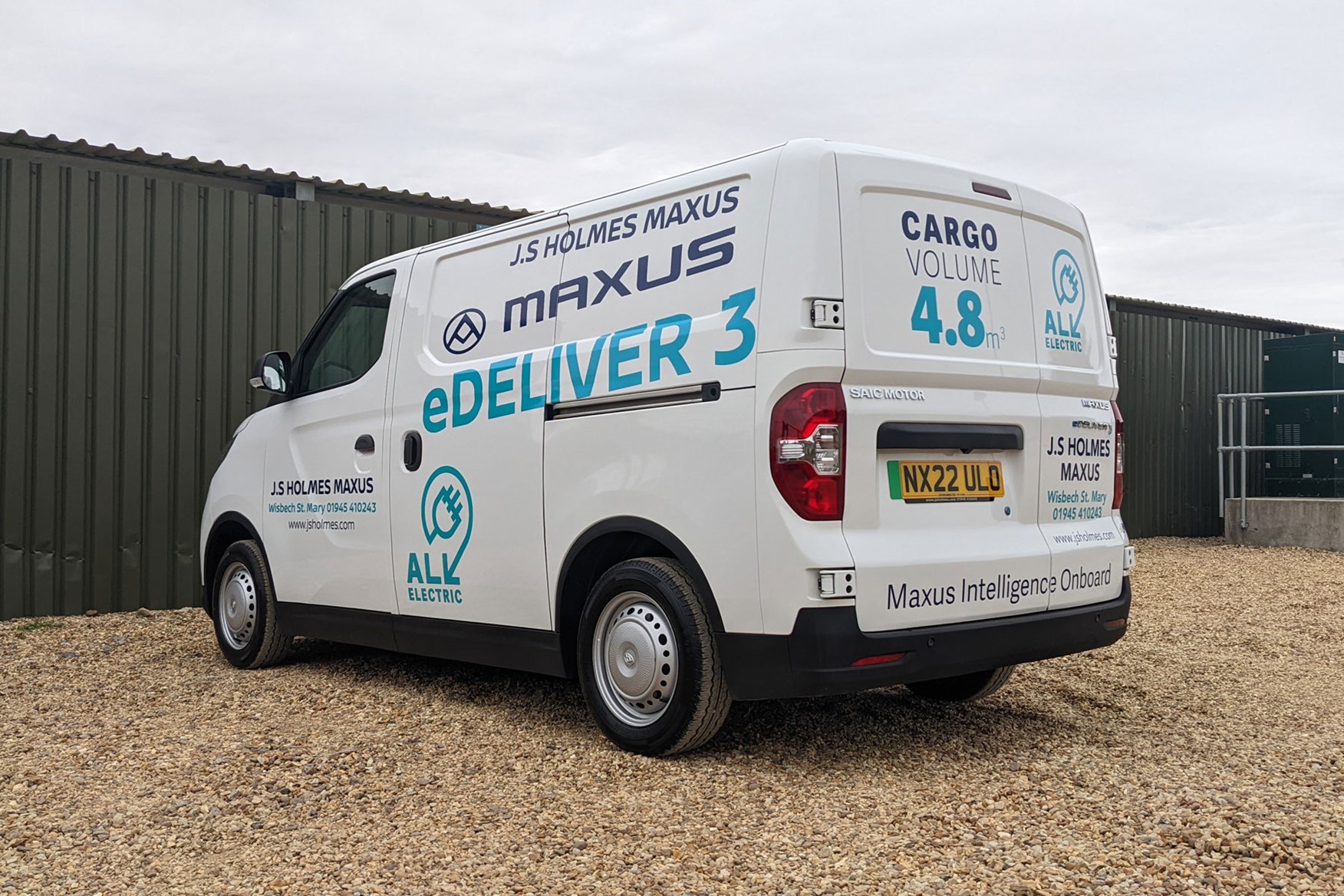
This pricing is very much in line with the amount you’ll pay for rival vans with similar battery capacity – which is to say the 52.5kWh eDeliver 3 is priced slightly less than a 50kWh model from the Stellantis family of electric vans, while the 35kWh eDeliver 3 is about £3-4,000 cheaper.
Aspects of the Maxus may make it a slightly tough sell by comparison – the equivalent Toyota Proace Electric has a larger load area and more conventional interior, for example. But we say again how impressed we were by the driving range accuracy the eDeliver 3 offers.
Maxus eDeliver 3 warranty
The whole van has a five-year / 60,000-mile warranty, while the battery pack has an eight-year / 100,000-mile warranty.
Maxus eDeliver 3 servicing intervals
The service intervals for the eDeliver 3 are 18,000 miles or two years, whichever comes sooner.
Maxus eDeliver 3 standard equipment
Maxus only sells the eDeliver 3 in a single specification and there are few options.
These are the standard equipment highlights:
- Two driving modes
- Three energy recovery (regeneration) modes
- Air-conditioning
- Automatic lights
- Electric mirrors
- Electric windows
- Reach and rake adjustable steering wheel with multifunction controls
- 7.0-inch touchscreen with Bluetooth
- Reversing camera
- Rear parking sensors
- Heated seats
- Bulkhead
- Stainless steel load floor
- Six load-lashing rings
The available options include alloy wheels, a windowed bulkhead, and a choice of three paint colours – though most eDeliver 3s are imported in white.
Details of safety and security equipment are in that section, below.
Electric vehicles have fewer moving parts, making them fundamentally less prone to failure than diesel models, so we’re not expecting any huge issues here. The eDeliver 3 has been available to buy for a little while now, and there are no signs of any reliability horror stories.
Own an eDeliver 3? Let us know if you’ve found it problematic or brilliantly reliable via the Parkers feedback email address.
- Well behind what we’ve coming to expect from a modern van
Basic stuff only here. The e Deliver 3 comes with electronic stability control, seat belt reminder and a driver and a passenger airbag (actually, that’s not bad, as many vans only include an airbag for the driver).
You also get front and rear disc brakes. But there are no high-tech active driver aids available at all.
As for security, you get an immobiliser but no alarm.
The bolts for the rear door hinges are exposed, which strikes us as a bit of vulnerability, so consider some additional security measures a priority.
Which MAXUS e Deliver 3 is best for me?
Since the e Deliver 3 comes in a single van size at present, with a single choice of drivetrain, really the only decisions you need to make about it are what size of battery is best for you and this choice might well have been made for you depending on what the brand has available.
Slightly unusually for an electric van, the bigger battery version of the Maxus has the higher payload rating, which means you can have the best of both driving range and carry capability in one vehicle here.
There isn’t much in it, payload wise – 865kg vs 945kg – so if you don’t need the longer driving range there is a useful saving to be had on the list price.
We think most people will be better off with the bigger battery version overall, though.






















